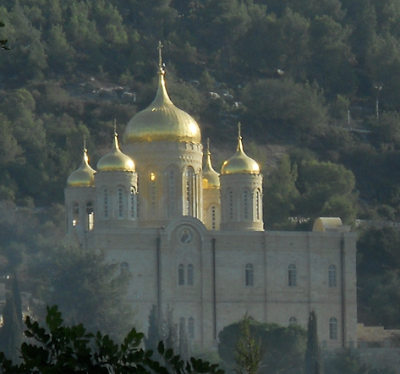We started our tour at the Church of Saint John the Baptist, built on the spot where Christians believe John the Baptist was born.
The courtyard in front of the Church of Saint John the Baptist has tiles with the same prayer written in every major world language.
The crest of the Franciscans, a Roman Catholic religious order that has been tasked by the Pope to be the official custodians of the Holy Land.
Another courtyard in the Church of Saint John the Baptist complex.
There was a priest conducting a service during our visit to the church. I believe parts of his sermon were in Hebrew, which struck me as very odd. Hebrew is so intertwined with Judaism that it is weird to think of any other religion incorporating Hebrew into their practices.
The audience consisted solely of nuns. All were singing, and one was even playing a guitar!
As we left the Church of Saint John the Baptist, we passed one of the few synagogues of Ein Kerem. In the background is the bell tower of a church. Nearby were the remnants of the tomb of a revered Muslim man. Throughout Israel, it is possible to find places where the three Abrahamic faiths meet.
The paths we took to travel through Ein Kerem were beautiful. It was hard not to stop and stare at all of the idyllic scenery.
Our next stop was the monastery of Notre Dame de Sion. It was founded by two French brothers who were born Jewish but converted to Christianity.
The gardens of the monastery were beautiful. The complex serves as a guest house for tourists looking to get away from the hustle and bustle of Jerusalem.
A cemetery took up a large portion of the monastery grounds. This picture shows the graves of several nuns who spent their lives at Notre Dame de Sion. Nearby were the graves of terminally ill people who chose to spend their last days in the quiet solitude of the monastery.
The monastery had great views of the Shephelah, the region of Israel that contains the hills of Judea.
A beautiful Russian Orthodox church nestled in the hills of Ein Kerem. Construction was started by Elizabeth of Russia in the 1910s, but was stopped after she was executed during the 1917 Bolshevik Revolution. Funding for its completion wasn't collected until after the fall of the Soviet Union and it was not finished until a few years ago.
The final church we visited was called the Church of the Visitation. It is venerated as the site where Mary, mother of Jesus, visited Elizabeth, mother of John the Baptist.
During Mary's visit to Elizabeth, Mary recited her song of praise called the Magnificat. Like at the Church of Saint John the Baptist, the courtyard of the Church of the Visitation is filled with tiles with lyrics from the Magnificat in every major world language.
The visitation as depicted through sculpture.
The flag of the Crusader Kingdom of Jerusalem and the Jerusalem cross--one big cross with four smaller ones--can be found throughout Ein Kerem.
Beautiful artwork can be found all over the Church of the Visitation.
More beautiful artwork in the Church of the Visitation.
A fairly modern style of art that depicts Mary and the baby Jesus.
The rock that Elizabeth hid behind to protect John the Baptist from marauding Romans.
The view from outside the entrance to the Church of the Visitation.
Out last stop was to Mary's Spring, which is currently the site of a mosque.
Mary's Spring is a freshwater spring that Christians believe to be the site where Mary and Elizabeth met.
The interesting design of the drainage path for the spring. Whoever designed this was not too intelligent because it is an uphill climb, so water will never make it to the hole.
Before we left, we stopped for ice cream, or gleedah in Hebrew. I had the M&M's flavor; it was delicious!


























No comments:
Post a Comment